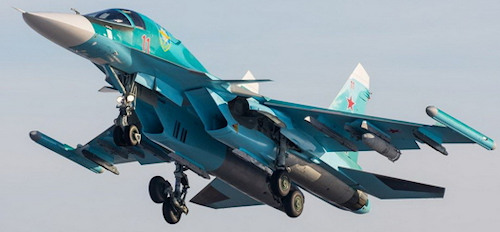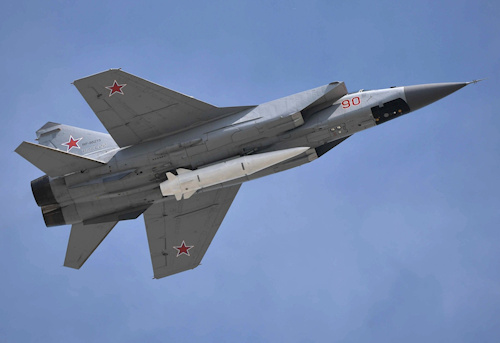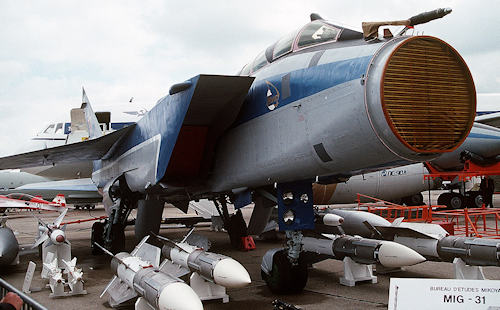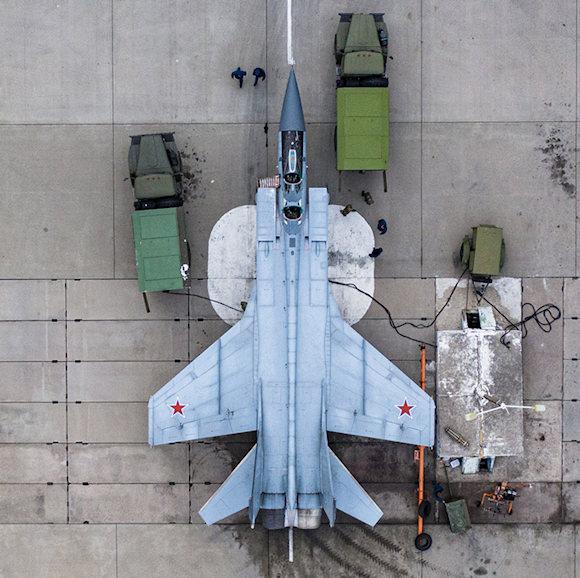Five years after the stable return to the Middle East with its own stable military base in Syria, even though the total percentages of Russian arms exports have decreased in the period 2016-2020, Russia continues to move in the arms market trying to fill any space possibly left vacant by the United States.
In particular, the export of combat aircraft and helicopters drives the entire sector.
Moscow's expansion of weapons systems sales brings with it not only money but a growing geopolitical influence, rekindling the old dichotomy with its US counterpart.
Some recent examples
To date, Egypt has already received at least 12 Sukhoi Su-35 advanced multi-role fighter jets, the first trance of an overall order of 241, despite cashing in US threats. And following Washington's refusal to sell its 35th generation F-XNUMXs to Cairo ...
After choosing the Russian S-400 anti-aircraft defense systems, Turkey (a NATO member) appears to be in advanced talks for the acquisition of the Su-35 as well as for the fifth generation Su-57 platform, after being excluded from the program. F-35, from the USA. As if this were not enough, on March 12, Russia announced that it was ready to open official negotiations with Ankara to help in the development of Turkish XNUMXth generation fighter, the TF-X (1)
Algeria, Russia's largest customer in the MENA area, will receive 14 upgraded Su-34 light bombers this year (photo below), but also appears to be interested in the Su-57(2) (3).

Iran, a longstanding customer of Russian arms since the time of the Shah, is now released from the decade-long United Nations embargo on arms imports. Tehran is now free to consider what the Russian Federation has to offer on the market(4).
Russia's share of global arms exports reached 21% in 2015-19, making it the second largest exporter in the world after the United States, according to data from the Stockholm International Peace Research Institute (SIPRI).(5).
All this, without considering the increasingly consolidated partnership with China (and the related increase in the volume of Chinese requests for armament and technology) and India.2.
Is all this leading to the quick scrapping of the MiG-31? No way
Entering service in 1981, the Mig-31 was the first Generation IV fighter aircraft to enter service. Despite some limitations relating to maneuverability, essentially linked to the age of the platform, it is nevertheless still considered one of the most capable of the Russian Air Force in terms of cruising speed, range, altitude (over 80.000ft!), Load / engagement capacity.

The platform was developed on the basis of the MIG-25 interceptor Foxbat Generation III and was dubbed "Super-Foxbat" in a report to Western intelligence by Soviet deserter pilot Viktor Belenko.
Il foxhound was the first fighter aircraft in the world to use a "phased array" radar Zaslon, and remains the fastest fighter jet to enter service, besides the Foxbat. The dimensions of the Zaslon and its accuracy puts the foxhound in the conditions of competing in a league of its own in terms of Situational Awareness.
The aircraft was unmatched in some of its flying performance. Capable of covering all the vast northern and central Asian territories of the Soviet Union, the MIG-31 had an extremely long "action arm" and was the world's first aircraft of its kind capable of navigating at supersonic speeds. . The aircraft's maximum speed remains uncertain, with most sources indicating a speed greater than Mach 2.8, and others even reporting greater than Mach 3.
The MiG-31 is one of the most widely deployed fighter aircraft in the world by the Russian Aerospace Forces, with several hundred reserve units. Initially, the Soviet Union was supposed to replace the platform with the new generation MiG-31M design, which was considerably larger and used new D-30F6M engines, digital flight controls, and a multi-function CRT cockpit display. , among other new features.

The economic crisis in Russia led to the cancellation of this program shortly before starting the series production cycle, in the mid-90s, although many features of the MiG-31M, including radar Zaslon-M (greatly improved) and avionics, have been integrated into the original structures of the MiG-31B foxhound to improve them to the MiG-31BM standard.
Of the BM version of the foxhound, which provides for the integration of radar Zaslon-AM (more advanced version of the radar) and of the GLONASS satellite guidance system, there is the K variant designed specifically as a transport platform for the hypersonic missile Kinzhal (photo). The MIG-31, in this case, serves as the first transport stage for the missile system Kinzhal (codename Kh-47M2, NATO code: SA-N9 Gauntlet), accelerating the missile to a predetermined altitude that allows a strategic range of 2000 km.
The vast majority of Russia's active MiG-31 fleet has currently been upgraded to the MiG-31BM standard, with some having undergone further improvements to be brought to the MiG-31BSM standard: increased cruising speed, new central computer, and refueling parcel in fly.
Weapon systems
The new interceptors foxhound have been upgraded with R-77 and R-37 active radar missiles, which can engage up to 110 km and 400 km respectively, of which this aircraft can carry four of each type.

At the moment, the R-37 is unrivaled in terms of speed and range, and carries a 61kg warhead. The ability to operate it at such distances is facilitated by the radar power of the Zaslon-M which can detect large and medium-sized aircraft even over 400 km.
It took several years before rival aircraft began to be equipped with similar radars, specifically designed for air / air combat. After the USSR started using it Zaslon, twenty-one years later, Japan equipped the F-2 and the USA, 24 years later, the F-22.
The latest weapon system to enter the MIG-31 K inventory is the Kh-47M2 hypersonic missile. The Kinzhal, which appears to be a basilistic missile Iskander with air-launched anti-ship engagement capability. It was designed to make the most of the long-range flight capability of the MIG-31 interceptor. In a hypothetical confrontation with NATO on the European continent, Russia would use the Kinzhal to degrade the Alliance's Command and Control (C2) and Support capabilities.
Motor
The D-30F6 of the foxhound it is the most powerful engine - by a considerable margin over the closest rival - ever integrated into a Generation IV fighter jet.

Its performance is sufficient to allow the aircraft to operate at extreme altitudes of 25 km.
While most fighters and interceptors cannot launch missiles at high altitudes, the foxhound he can use his weapons at maximum altitude, which allows them to reach much farther targets.
Weight :
The MiG-31 also boasts the record as the heaviest military jet ever built for air-to-air combat in service anywhere in the world: approximately 41.000 kg depending on use and fuel load. About twice the size of the F-15C Eagle, the main fighter produced for the US Air Force during the Cold War. Over 10.000 kg more than the F-22, which boasts being the heaviest Western fighter in service at present.
Role: factotum
According to Aleksandr Osokin, the chief designer of the Sokol plant, where all the upgrades of the MIG-31 were produced, the new variants of the foxhound they are approximately 2,6 times more capable than the original Cold War era models.

The aircraft were designed not only to intercept all types of enemy aircraft (from bombers to fighters to reconnaissance) but also equipped with missiles widely capable of intercepting low-flying cruise missiles.
By exploiting the structure of the foxhound and the large number of such aircraft that Russia has at its disposal, the aircraft has also been adapted for roles beyond air / air combat. As widely known, this included the air carrier's predispositions for the anti-satellite function, taking advantage of the very high operational speeds and altitudes it is capable of reaching and their load capacity, i.e. both the ability to carry very large missiles necessary for achieve goals in orbit.
The MIG-31K variant was introduced into service in early 2018 with a hypersonic tactical ballistic missile capability, as an attack and maritime attack aircraft: the Kh-47M2 missile, in fact, is capable of threatening a wide range of range of land and surface targets up to 2000 km, with high reliability and accuracy, at a speed of Mach 10.
Theoretically, the foxhound is expected to remain in service until 2040: this is very likely as it remains the most important Russian fighter jet currently in service with the widest range of roles it can play and the growing versatility gained through the integration of new weapon systems.

The aircraft are currently used both for maintaining air superiority over the entire territory of the Russian Federation and for the protection of the Russian Arctic area, thanks to the suitability of deployment on icy runways and being able to withstand extreme temperatures. Being up to now able to cover an area of 1000/1200 km and to detect / engage targets from such distances, it is estimated that no aircraft in the world is better suited for such a role.
The development of the MiG-31 successor, the MiG-41, is currently being studied in Moscow, which will be able to play similar roles but will have far superior performance across the spectrum. The new aircraft will be able to fly hypersonically at speeds above Mach 5, will have a higher altitude ceiling than the foxhound to fly into near space. Other features have also been speculated, including artificial intelligence integration, a revolutionary new sensor suite, and new hypersonic weapons.
Ultimately, the MiG-31 certainly remains a concern for NATO countries: a dangerous old man, designed to fill different roles and who, thanks to all the upgrades received, will continue to be respected by the rest of the world.

(1)https://tass.ru/armiya-i-opk/10892803?nw=1615587365000
(2)https://avia.pro/news/alzhir-kupil-14-rossiyskih-istrebiteley-su-57e-za-...
(3)https://tsargrad.tv/news/alzhir-stal-pervoj-stranoj-kotoraja-zakupit-u-r...
(4)https://sicurezzainternazionale.luiss.it/2020/10/18/iran-scade-lembargo-...
(5)https://sipri.org/sites/default/files/2021-03/fs_2103_at_2020.pdf
1https://en.topwar.ru/189792-sochetanie-prevoshodstva-v-vozduhe-s-udarnoj...
2https://thediplomat.com/2021/12/why-did-russian-president-putin-visit-in...
Photo: MoD Fed Russa / web












